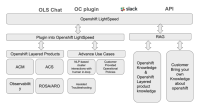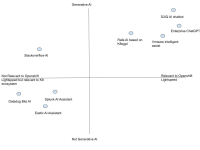-
Outcome
-
Resolution: Done
-
Major
-
None
-
Product / Portfolio Work
-
0% To Do, 0% In Progress, 100% Done
-
False
-
-
False
-
None
Background
OpenShift LightSpeed draws its inspiration from the everyday use of ChatGPT by individuals around the world. It aims to translate this inspiration into an OpenShift context, empowering OpenShift users by integrating Large Language Model (LLM) technology for enhanced operation and management of OpenShift environments.
GOAL / Success Criteria
Our goal is to enrich the OpenShift subscription value by introducing an interactive interface for OpenShift users. This interface, which can take the form of chatUI , CLI, SLACK, or API, will be integrated into OpenShift. It will connect users with various LLM providers, such as OpenAI, Watson X, Azure AI, and others, allowing OpenShift users to:
- Generate OpenShift-specific content.
- Inquire about OpenShift-related topics.
- Produce YAML or OC commands.
- Clarify OpenShift concepts.
- Interpret logs, events, and alerts.
- Explore OpenShift materials.
- Conduct root cause analysis of issues.
Why are we building OpenShift LightSpeed? What is the business justification?
To foster growth within the OpenShift ecosystem, it's crucial to broaden our audience. Simplifying the learning curve of OpenShift can significantly aid in achieving this, making it easier and quicker for users to operate, manage, and deploy applications. The introduction of OpenShift LightSpeed aims at enhancing OpenShift user productivity, thereby driving two main outcomes:
- [Primary, Long-Term]: Facilitate OpenShift adoption among individuals who might be hesitant due to its perceived complexity. Targeting this group could tap into a large, underexplored market requiring substantial education.
- [Secondary, Short-Term]: Boost the efficiency of existing OpenShift experts, increasing their engagement and perceived value of the platform. This is expected to lead to a greater likelihood of subscription renewals.
Stay Relevant and Protect OpenShift Business
With LLM-driven interfaces becoming increasingly common across various products (e.g., Bank of America's Erica®), it's vital for OpenShift to keep pace. The adoption of LLM technology by other Kubernetes vendors to improve user productivity underscores the need for OpenShift to innovate. Similarly, new open-source projects like K8sgpt utilizing OpenAI for Kubernetes assistance highlight the industry's direction.
Market Problem
The IT industry is currently experiencing a notable talent gap. According to IDC’s FutureScape and Forbes, the lack of digital skills and Kubernetes/OpenShift expertise is hampering companies across sectors. This skill shortage is reflected in the thousands of job postings seeking Kubernetes expertise. Furthermore, Gartner predicts that by 2025, a significant portion of operational tasks will require skills that the current workforce does not possess.
Source : https://www.forbes.com/sites/forbestechcouncil/2023/05/10/addressing-the-kubernetes-skills-gap/?sh=59fa769123f4 , https://www.forbes.com/sites/forbestechcouncil/2023/05/10/addressing-the-kubernetes-skills-gap/?sh=304635a223f4
HighLevel Architecture Overview
Competitive Analysis
Note : if you have any suggestions then us this google doc https://docs.google.com/document/d/1GUmMcmJRHKzQTm9k_PG6dYOm0KP69UUFKmmU8mpQqXI/edit to edit and reach out to gausingh@redhat.com

